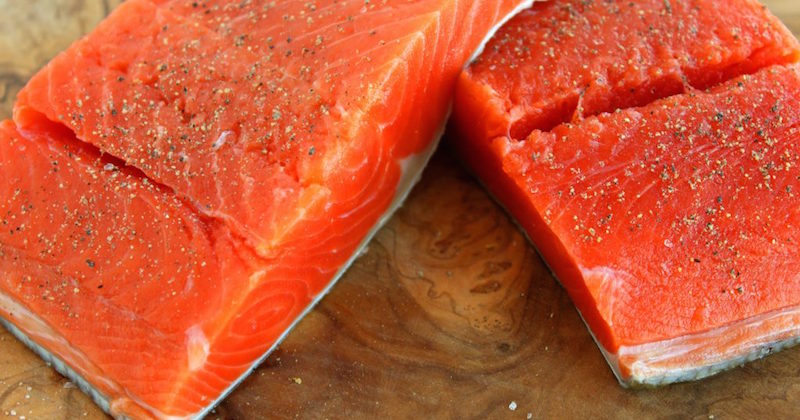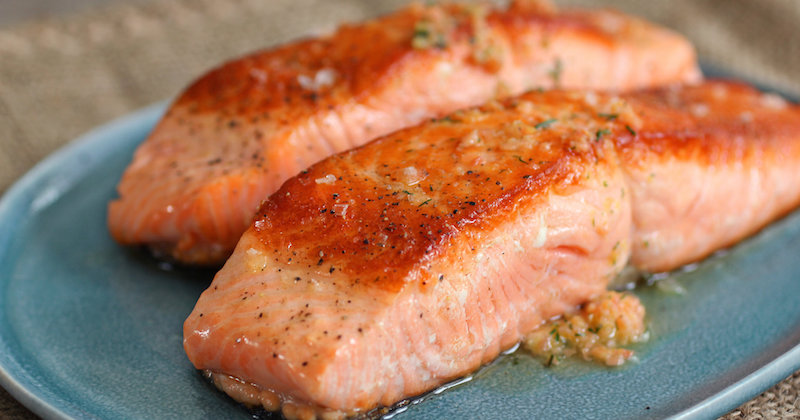Why It Matters That You Choose A Wild-Caught Salmon Over Farmed Salmon
Last updated on
Salmon can be one of the best things you can eat for your health … but not all salmon are created equal. There are big differences in quality between farmed salmon you typically find at the grocery store, and the wild-caught salmon.
Wild-caught, sustainably-raised salmon is packed full of nutrients and healthy fats. A lot of people eat it multiple times a week to reap the most benefits. Yet others tell you to watch for things like exposure to contaminants and environmental harm.
What gives?
Sorting through this information can be confusing. It’s easy to get comfortable with the standard rotation of beef, chicken, and pork and stop worrying about seafood completely.
But finding the right salmon (one that’s as nutritious as possible and ethically-sourced) is worth the trouble. Keep reading to see why.
The Natural Health Benefits Of Salmon
Here are some of the most important reasons why you should make wild-caught salmon—the kind you can order direct from suppliers like Alaska Gold Seafood—a major part of your Paleo diet:
1. Extremely High Omega-3 Fatty Acid Content
Salmon is loaded with the long chain omega-3 fatty acids DHA and EPA.
We need a balanced ratio of omega-3 to omega-6 fatty acids for optimal health. Yet the typical modern diet leaves us with multiple times more omega-6s than we need (1). With the balance so out of whack, you end up with an increase in all inflammatory diseases, everything ranging from diabetes and obesity, to metabolic syndrome or autoimmune disorders.
Wild-caught salmon can help. It has many times more omega-3s than farmed salmon. That makes it the best choice to fight inflammation, improve brain function, protect your heart, and reap all the other awesome benefits that come from balancing your omega-3:omega-6 ratio.
Just a single serving of wild-caught salmon has over 500 mg of DHA and EPA (3)!
2. Loaded With Hard-to-Find Vitamins and Minerals
Salmon is also high in vitamins and minerals which are critical for your health, and hard to find in other foods.
Vitamins B12 and D are key players here. Vitamin B12 is essential for proper red blood cell formation, synthesizing DNA, and a lot more (4). Vitamin D supports healthy bones and teeth, your immune system, brain function, and mental health (5). These vitamins are tough to find in other foods, but salmon is absolutely loaded with them. Just a single 100-gram serving contains more than the recommended daily value of both vitamins (6).
Salmon is also high in the mineral iodine, which is essential for thyroid and immune system function. Common table salt is enriched with iodine to overcome iodine deficiencies, which are extremely common.
But Paleos typically eat fewer salty foods, and many of them switch to sea salt (which isn’t iodized). So it’s critical to make sure you’re getting enough iodine in your diet.
Finally, salmon is also packed with selenium. This antioxidant mineral has been linked to decreased joint inflammation, as well as protecting brain against oxidative damage (8). Selenium also counteracts any adverse effects of mercury exposure, so you don’t have to worry about that when you’re eating salmon (9).
3. High In Protein, With A Balanced Profile Of Essential Amino Acids
Salmon is high in protein. Just one 100-gram serving (around 3.5 ounces) contains 23 grams of protein, which is slightly less than a steak or chicken breast of comparable size but certainly nothing to sniff about!
Research also shows that the amino acids in salmon are more “bioavailable” (easier for your body to absorb and use) than amino acids from beef, pork, or chicken (10).
Salmon has an extremely balanced quantity of essential amino acids. It’s especially high in taurine, a powerful antioxidant.
Wild-Caught Salmon Vs. Farmed Salmon: Why It Matters
Unfortunately, the vast majority of salmon sold in the United States today is “farmed salmon”—the seafood equivalent of a factory farm. In terms of nutrition, ethics, and sustainability, wild-caught salmon is light-years ahead of the farmed stuff.
Here are some of the most important differences … and why they matter for your health.
1. Wild-Caught Salmon Has More Nutrients
Wild-caught salmon has multiple times more omega-3 fatty acids than farmed salmon. One study found that wild salmon had 12.4 times as many omega-3s than omega-6s, while the farmed salmon only had 2.9 times as many (12).
Wild-caught salmon has a lot more vitamins and minerals. One study found that farmed salmon only had about one-quarter the vitamin D of wild-caught salmon (13). This is critical because salmon is one of the few foods that offers sizable amounts of vitamin D. Eating a wild-caught makes the most of it.
2. Farmed Salmon Is Exposed To More Toxins and Contaminants
Farmed salmon has much higher rates of contamination and exposure to toxic chemicals.
One study found that farmed salmon had higher levels of 14 different contaminants, including polychlorinated biphenyls (PCBs), dioxins, and DDT (an insecticide) (14).
It’s exposure to toxins like these that causes people to hesitate before eating seafood and drives health professionals to recommend limiting intake of it, when in reality, you could be eating it much more often … as long it is of high quality.
3. Wild-Caught Salmon Can Be Sourced Sustainably And Ethically
Just like factory farming for chickens and cows, salmon farming creates unhealthy, unnatural living conditions for salmon before they are harvested.
You end up with thousands (or even hundreds of thousands) of large, carnivorous fish trapped in small, crowded nets. Living in such close quarters in salmon feedlots makes farmed salmon more vulnerable to bacteria and viruses, which can spread through the population quickly.
There’s also the diet to think about. Farmed fish are fed corn and grains, which aren’t part of their typical diets. This changes the very makeup of the fish, forcing farmers to use synthetic pigments to turn the flesh pink just so things “look right” (otherwise their salmon would be pale gray!)
4. Farmed Salmon Could Be Genetically Modified
Farmed salmon also has the dubious title of being the first genetically modified animal approved for human consumption.
In late 2015, the FDA approved a specific type of Atlantic salmon genetically modified to grow twice as fast as natural salmon, calling it “as safe to eat as non-GMO salmon” (15).
This raises all kinds of concerns about ethics, food safety, and the effects on local ecosystems. Because we don’t fully understand the potential for long-term health effects, many people will choose to stay away from this stuff.
Where Can You Find High-Quality Salmon?
Salmon is easy to find. You can probably find it in practically every grocery store in your town.
You can also find salmon online through websites like Alaska Gold Seafood, which is a great way to source wild-caught, sustainably-fished salmon without having to worry about quality.
The truly important issue to consider: where did the salmon come from before it got to the store?
The vast majority of salmon we eat comes from:
- Atlantic Ocean. There are only a few wild salmon runs in the Atlantic left. Because these runs are too small to fish commercially, all Atlantic salmon found in grocery stores, restaurants, and elsewhere is farmed.
- Pacific Ocean. More salmon is wild-caught in the Pacific, though there are serious concerns about sustainability (16).
- Alaska. All Alaskan salmon is wild-caught because Alaska law prohibits salmon farms. Alaskan laws also ensure salmon is fished in a sustainable way. There’s actually enough wild-caught salmon produced in Alaska each year to feed the entire population of the United States!
Salmon caught in Alaska offers the best balance of nutrients and sustainability, thanks to strategic conservation efforts and strict sustainability laws. But Alaskan salmon can be hard to find at the grocery store, especially if you don’t live in the States.
It’s much easier to buy salmon online from a reputable source and have it sent straight to your door.
Look for Alaskan salmon rated as “green” or “best choice” by the Monterey Bay Aquarium Seafood Watch Program, an organization that helps consumers choose seafood fished in a sustainable way that respects sea life and habitats (17). Ideally, salmon should also be certified as a sustainable seafood by the Marine Stewardship Council (18).
A few suppliers use hooks and lines to deliver the highest-quality wild-caught salmon in a sustainable way. Using the right combination of lines, lures, and boat speed, fishermen are able to minimize stress on the fish and “bycatch” (other marine life caught unintentionally).
Less than five percent of Alaskan seafood comes from hook and line fishermen, as most operations use other methods to maximize their catch. But, what hook and line fishermen lack in quantity, they make up for in quality and care in handling.
Finally, look for salmon that comes direct from the producer. Buying direct ensures maximum freshness, and it helps you save money that would have gone to a middleman. It’s even more cost-effective if you have a large freezer and order in bulk!
This article is shared with permission from our friends at blog.paleohacks.com.
Some of the links I post on this site are affiliate links. If you go through them to make a purchase, I will earn a small commission (at no additional cost to you). However, note that I’m recommending these products because of their quality and that I have good experience using them, not because of the commission to be made.
Comments
Leave a Reply



































 JOIN OVER
JOIN OVER
What about tinned Alaskan salmon. Is it still good?